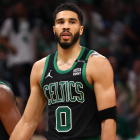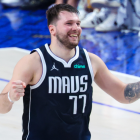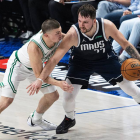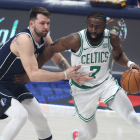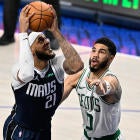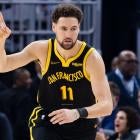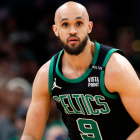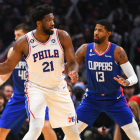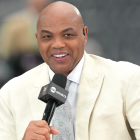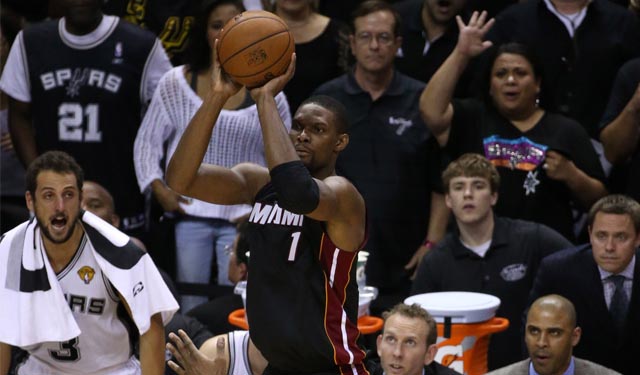
With the departure of LeBron James and the pairing with a Dwyane Wade who has become less and less reliable over the past two years, it's expected the Miami Heat will ask big man Chris Bosh to be their go-to scorer. For those who laugh at the notion of Bosh being the main focus for a playoff team, it's foolish to think he can't do it. Sacrificing the individual numbers for the greater good of the team isn't the same as being unable to consistently provide those statistics we use to judge players.
Bosh returns to a role he filled admirably during his time with the Toronto Raptors. In seven seasons with the Raptors, Bosh averaged 20.2 points and 9.4 rebounds. For five straight seasons, he averaged at least 22.3 points and maxed out at 24.0 points per game (ninth in the NBA) in the 2009-10 season. He can carry the scoring load and this time he'll have the added advantages of having a better overall understanding of how to play the game, a better supporting cast, and a better coach than he previously had.
He had so much responsibility as an interior defender over the last four years that he was willing to sacrifice his role on offense and be more of a safety valve for the other stars. This allowed him to conserve energy and do what was asked of him on a nightly basis. In his new role, he'll likely have supporting cast members picking up the load on defense and allowing Bosh to concentrate on being the offensive focus.
The question becomes not if he can handle the scoring load but how he'll do it.
Bosh has spent his last four years finding himself creeping farther and farther away from the basket. He didn't want to bang in the post with big men because it zapped his energy. And spacing the floor to give Wade and LeBron room to attack the paint was far more valuable than someone who would clog things up on the low block. Bosh took a very solid mid-range jumper and moved it out beyond the 3-point line over the the course of four seasons. The adaptable big man took more 3-pointers (218) in the 2013-14 season than he did in his seven years in Toronto (168).
Taking a look at the Heat Maps from basketball-reference.com, you can see just how vast the difference is from his last season in Toronto to what he became over his first four years in Miami:

As the NBA has evolved to a more perimeter-oriented game, so has Bosh. That worked as a safety valve for the Heat but do those 3-point attempts stick around in his revamped role? Bosh won't be asked to kick around the perimeter and wait for the swing pass on most possessions. Erik Spoelstra will undoubtedly design tweaks to his offensive principles to feature Bosh more without LeBron around, but it's hard to see how the Heat can implement this 3-point weaponry of Bosh's.
While Bosh is not the natural shooter that Kevin Love is, trying to find ways to use him in the same way the Timberwolves used their outside shooting big man over the last few seasons could provide some answers on how to maximize his skills. Love's work on the offensive end primarily came from a mixture of posting up (22.9 percent of possessions), spotting up (15.0 percent), offensive rebounds (9.5 percent), and pick-and-roll man (9.5 percent). Love is also a career 36.2 percent shooter from 3-point range, so spreading the floor with him is fairly natural.
Bosh's career best 3-point shooting season came in 2013-14 when he made just 33.9 percent of his shots from beyond the arc. That's a big difference between he and Love, especially considering Love made 190 3-pointers and Bosh attempted just 218 of them. However, over the past two playoff runs, Bosh has shot 40.5 percent from 3-point range in both postseasons. He even doubled his attempts from the 2013 playoffs to the 2014 playoffs.
Bosh's four main offensive scoring situations last season were in spotting up (33.4 percent of possessions), playing as the pick-and-roll man (18.3 percent), cutting to the basket (12.8 percent), and posting up (7.5 percent).
His post-game was effective, even though he didn't find himself doing it all that often. He was in the 90th percentile in terms of points per possession on post-ups, but he was able to maximize those opportunities by having the floor spaced and working quickly. It will be hard to have that luxury as the main guy. He'll be spotting up less and scoring off fewer cuts without LeBron out of town, but you can still use him effectively in the pick-and-roll.
The keys to him turning those pick-and-pops into 3-point attempts could rest solely on his comfort with that type of shot (it's a much tougher gather than just spotting up for a 3-pointer) and how effective Dwyane Wade and Mario Chalmers are at running those pick-and-pops with him. The reason Bosh's 3-point shooting still being a weapon is so important is because the Heat don't have the same 3-point shooting they had last season.
LeBron was a good shooter from outside, and James Jones (Cleveland) and Ray Allen (Cleveland too?) have all left Miami. The Heat are left with Wade (historically one of the worst 3-point shooters of all time) and Deng (a very inconsistent outside shooter despite two solid seasons) taking up a lot of minutes on the court. It will be up to Bosh, Josh McRoberts, Mario Chalmers, Norris Cole, and Danny Granger to keep the floor spread in Spoelstra's offense.
The game has evolved to value 3-point shooting and the champions of the past half decade have proven that to be true time and time again. Bosh's evolution has been impressive, but if it can't continue, the Heat regress into being an outdated sort on offense.













